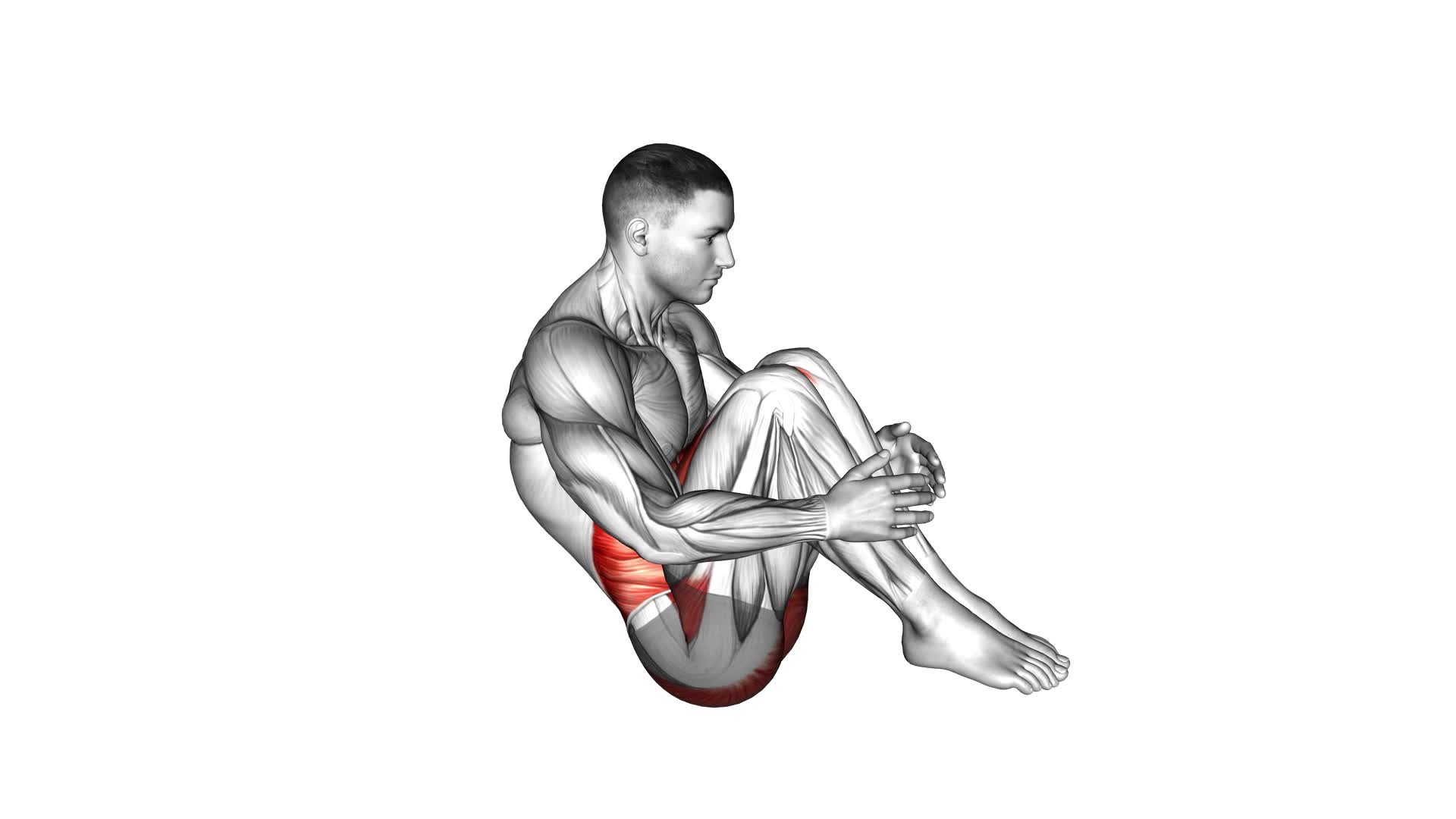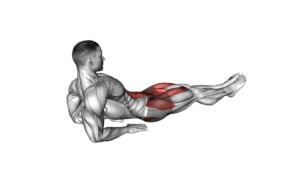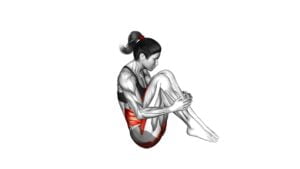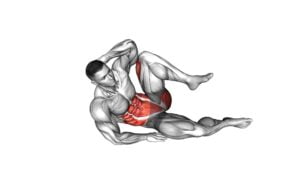Lying Tuck Crunch – Video Exercise Guide & Tips

Looking to tone your abs and strengthen your core? Look no further than the lying tuck crunch! This exercise targets your abdominal muscles while also engaging your hip flexors.
Watch This Exercise Video
In this video exercise guide, we'll show you the proper form and technique for performing the lying tuck crunch, as well as common mistakes to avoid. Whether you're a beginner or more advanced, we've got modifications for all fitness levels.
Get ready to maximize your results with this effective ab workout!
Key Takeaways
- Lying Tuck Crunch targets the rectus abdominis muscles and helps strengthen and tone the abs.
- Proper form and technique, such as maintaining core engagement and avoiding jerky movements, are crucial for effective engagement of the abs and to prevent injuries.
- Controlled breathing enhances the effectiveness of the exercise and stabilizes the body.
- Modifications and variations can be made to target different areas of the abs and increase the difficulty of the exercise.
Benefits of the Lying Tuck Crunch
The lying tuck crunch offers three key benefits for your abdominal muscles.
This exercise primarily targets your rectus abdominis, commonly known as the six-pack muscles.
First and foremost, the lying tuck crunch helps to strengthen and tone your abs. By contracting and engaging your abdominal muscles, you're able to effectively work on building a stronger core.
Additionally, this exercise can also improve your overall stability and balance. As you perform the lying tuck crunch, you're required to engage your core muscles to maintain proper form and balance. This can translate into improved stability in everyday activities and sports.
Lastly, the lying tuck crunch offers variations that allow you to target different areas of your abs. For example, you can perform the exercise with your legs straight and raised, or with your knees bent. These variations provide a different level of challenge and can help you target specific areas of your abdominal muscles.
Incorporating the lying tuck crunch into your workout routine can help you achieve a stronger, more defined midsection.
Proper Form and Technique
To perform the Lying Tuck Crunch with proper form and technique, it's important to focus on core engagement. Keep your core muscles activated throughout the exercise by pulling your belly button towards your spine.
Additionally, injury prevention techniques, such as avoiding jerky movements and maintaining a controlled pace, can help protect your back and neck during this exercise.
Core Engagement Tips
Engage your core effectively with proper form and technique during the Lying Tuck Crunch exercise. To ensure optimal core activation and muscle targeting, follow these tips:
- Start by lying on your back with your knees bent and feet flat on the floor.
- Place your hands behind your head, keeping your elbows wide.
- Lift your head and shoulders off the ground, engaging your core muscles.
- As you exhale, contract your abdominal muscles and bring your knees towards your chest.
- Slowly lower your legs back to the starting position while maintaining core engagement.
Remember to keep your movements controlled and avoid straining your neck or using momentum to perform the exercise. By focusing on proper form and technique, you can maximize the effectiveness of the Lying Tuck Crunch and achieve better results for your core muscles.
Injury Prevention Techniques
Practice proper form and technique to prevent injuries during the Lying Tuck Crunch exercise. Injury prevention techniques are crucial for ensuring a safe and effective workout.
To protect yourself from potential harm, focus on engaging your core throughout the movement. This will help stabilize your spine and reduce the risk of straining your back or neck. Maintain a neutral spine position by keeping your head, neck, and shoulders in alignment. Avoid pulling on your neck or using momentum to lift your upper body.
Instead, use your abdominal muscles to initiate the movement, keeping them contracted throughout. Remember to breathe steadily and avoid holding your breath.
By following these injury prevention techniques and engaging your core properly, you can minimize the risk of injury and maximize the benefits of the Lying Tuck Crunch exercise.
To ensure a safe and effective workout, it's important to be aware of common mistakes that can lead to injuries.
Common Mistakes to Avoid
When performing the lying tuck crunch, it's important to be aware of common mistakes that can put you at risk. Incorrect form can lead to potential dangers such as strain on your neck and lower back.
It's crucial to maintain proper alignment throughout the exercise to avoid injury and get the most out of the movement.
Additionally, be cautious of overexertion, as pushing yourself too hard can lead to muscle strains or other injuries.
Incorrect Form Dangers
To avoid potential injuries, it's important to be mindful of common mistakes when performing the lying tuck crunch exercise. Improper technique can lead to incorrect form risks and pose dangers to your body. Here are some common mistakes to avoid:
- Arching your back: Keep your lower back pressed against the floor throughout the exercise to protect your spine.
- Pulling your head: Avoid straining your neck by keeping your head relaxed and your gaze towards the ceiling.
- Using momentum: Focus on using your abdominal muscles to lift your legs and hips, rather than relying on momentum.
- Holding your breath: Remember to breathe throughout the exercise to maintain proper oxygen flow.
- Overextending your legs: Keep your knees slightly bent to avoid putting excessive strain on your lower back.
Proper Alignment Importance
To maintain proper form and minimize the risk of injuries, it's essential for you to focus on proper alignment during the lying tuck crunch exercise.
Proper alignment is of utmost importance because it ensures that you're engaging the correct muscles and not putting unnecessary strain on your body.
When performing the lying tuck crunch, make sure your lower back is pressed firmly against the floor and your neck is relaxed.
Your knees should be bent at a 90-degree angle, and your feet should be flat on the ground.
Avoid pulling on your neck or using momentum to lift your upper body.
Overexertion Risks
To avoid overexertion risks and common mistakes, it's important for you to be mindful of your body's limitations and listen to its signals. Pushing yourself too hard can lead to overtraining hazards and increase the risk of muscle strain. Here are some key points to keep in mind:
- Gradually increase intensity: Avoid jumping into high-intensity workouts without building up your strength and endurance first.
- Take rest days: Giving your body time to recover is crucial for preventing overexertion and reducing the risk of injury.
- Listen to your body: If you feel pain or discomfort during an exercise, stop and assess if you need to modify or take a break.
- Proper form: Maintain proper form throughout the exercise to reduce the strain on your muscles and joints.
- Seek guidance: If you're unsure about a specific exercise or technique, consult a qualified fitness professional for assistance.
Modifications for Different Fitness Levels
You can modify the lying tuck crunch exercise to suit your fitness level. Whether you're a beginner or more advanced, there are several ways to make this exercise easier or more challenging.
For beginners or those with limited core strength, you can start by performing a modified version of the lying tuck crunch. Instead of lifting your legs and torso off the ground, you can keep your feet on the floor and focus on engaging your core muscles to lift your shoulders slightly off the ground. This reduces the intensity of the exercise while still targeting your abdominal muscles.
As you progress and gain more strength, you can gradually increase the difficulty of the lying tuck crunch. One way to do this is by lifting your legs and torso higher off the ground, creating a larger angle between your thighs and torso. This increased range of motion engages your abs and hip flexors more intensely.
Another modification for advanced fitness levels is to add a twist to the lying tuck crunch. As you lift your legs and torso off the ground, you can rotate your torso to one side, bringing your elbow towards the opposite knee. This adds an extra challenge to your oblique muscles and increases the overall difficulty of the exercise.
Remember to always listen to your body and progress at a pace that feels comfortable for you. By modifying the lying tuck crunch exercise, you can tailor it to your fitness level and continue to challenge yourself as you improve.
Tips for Maximizing Results
To maximize your results, focus on incorporating these tips into your lying tuck crunch exercise routine:
- Increase the intensity: To get the most out of your lying tuck crunches, try adding resistance by holding a dumbbell or a medicine ball against your chest. This will challenge your abdominal muscles even more and help build strength and definition.
- Engage your core: Throughout the exercise, concentrate on contracting your abdominal muscles and pulling your belly button towards your spine. This will ensure that you're targeting the right muscles and maximizing the effectiveness of each repetition.
- Maintain proper form: It's crucial to maintain proper form during the lying tuck crunches. Keep your lower back pressed against the floor and avoid pulling on your neck or using momentum to lift your upper body. This will help prevent injuries and ensure that you're engaging your abs effectively.
- Focus on controlled breathing: Effective breathing techniques can enhance the effectiveness of your lying tuck crunches. Inhale deeply as you lower your legs and exhale forcefully as you crunch up. This controlled breathing pattern will engage your core muscles and help stabilize your body.
- Progress gradually: As with any exercise, it's important to gradually increase the difficulty of your lying tuck crunches to continue seeing results. Start with a comfortable number of repetitions and gradually increase the number or add more resistance over time.
By incorporating these tips into your lying tuck crunch routine, you'll be able to maximize the intensity of your workouts and achieve better results.
Now, let's move on to a sample lying tuck crunch workout routine.
Sample Lying Tuck Crunch Workout Routine
To structure your sample lying tuck crunch workout routine, incorporate the following exercises and repetitions into your routine.
Start with the basic lying tuck crunch. Lie flat on your back with your legs extended and your arms at your sides. Engage your core and bring your knees towards your chest, lifting your hips off the ground. Hold this position for a few seconds before slowly lowering your legs back down to the starting position. Aim for 10 to 12 repetitions.
Next, incorporate some lying tuck crunch variations to target different areas of your core. Try the bicycle crunch, where you bring your opposite elbow towards your knee while extending the other leg. This exercise engages your obliques and improves your coordination. Aim for 10 repetitions on each side.
For an advanced core exercise, try the Russian twist. Sit on the ground with your knees bent and your feet flat on the floor. Lean back slightly and lift your feet off the ground. Twist your torso to the right and then to the left, touching the ground with your hands on each side. Aim for 12 to 15 repetitions.
Remember to always maintain proper form and engage your core muscles throughout the entire workout. As you progress, you can increase the number of repetitions or add weights for an extra challenge.
Frequently Asked Questions
How Many Calories Does the Lying Tuck Crunch Exercise Burn?
The lying tuck crunch exercise can be effective for burning calories. It targets your abdominal muscles and engages your core. However, the exact number of calories burned during this exercise can vary depending on factors such as your weight, intensity, and duration.
To get a more accurate estimate, you can use a fitness tracker or consult with a professional. Remember, consistency and proper form are key for maximizing the effectiveness of this exercise.
Can the Lying Tuck Crunch Help in Reducing Belly Fat?
The lying tuck crunch is an effective exercise for reducing belly fat. By engaging your abdominal muscles and targeting the lower abs, it helps to tone and strengthen your core.
Incorporating variations of the lying tuck crunch, such as adding resistance or using a stability ball, can further enhance the effectiveness of the exercise.
To perform the lying tuck crunch properly, lie on your back with your knees bent and feet flat on the floor, then lift your shoulders off the ground while bringing your knees towards your chest.
Is It Necessary to Use a Yoga Mat While Performing the Lying Tuck Crunch?
Using a yoga mat for the lying tuck crunch has its benefits. It provides cushioning for your back and prevents discomfort during the exercise. Additionally, it helps to maintain stability and grip while performing the movement.
However, if you don't have a yoga mat, you can still strengthen your core with alternative exercises like planks, Russian twists, or bicycle crunches. These exercises target the same muscle groups and can be just as effective.
Can the Lying Tuck Crunch Help in Improving Posture?
The lying tuck crunch is a great exercise for improving posture. By engaging your core muscles, it helps to strengthen your back and abdominal muscles, which are crucial for maintaining good posture.
Additionally, the lying tuck crunch benefits extend beyond posture improvement. It can also help to tone your abs, increase core stability, and improve overall body strength.
To add variation to your workout, you can try different lying tuck crunch variations like the bicycle crunch or reverse crunch.
How Often Should the Lying Tuck Crunch Be Performed for Best Results?
To get the best results from the lying tuck crunch, it's important to know how often to perform it. The lying tuck crunch frequency should be based on your goals and fitness level.
It's recommended to start with 2-3 times per week and gradually increase the frequency as you get stronger. Finding the optimal lying tuck crunch schedule that works for you is key.
Remember to listen to your body and give yourself enough time to recover between sessions.
Conclusion
In conclusion, the lying tuck crunch is a highly beneficial exercise for improving core strength and stability. By maintaining proper form and technique, you can effectively target your abdominal muscles while avoiding common mistakes.
Additionally, modifications can be made to suit different fitness levels, and incorporating these tips into your routine will help maximize your results. Try incorporating the lying tuck crunch into your workout routine for a challenging and effective core workout.

Author
Years ago, the spark of my life’s passion ignited in my mind the moment I stepped into the local gym for the first time. The inaugural bead of perspiration, the initial endeavor, the very first surge of endorphins, and a sense of pride that washed over me post-workout marked the beginning of my deep-seated interest in strength sports, fitness, and sports nutrition. This very curiosity blossomed rapidly into a profound fascination, propelling me to earn a Master’s degree in Physical Education from the Academy of Physical Education in Krakow, followed by a Sports Manager diploma from the Jagiellonian University. My journey of growth led me to gain more specialized qualifications, such as being a certified personal trainer with a focus on sports dietetics, a lifeguard, and an instructor for wellness and corrective gymnastics. Theoretical knowledge paired seamlessly with practical experience, reinforcing my belief that the transformation of individuals under my guidance was also a reflection of my personal growth. This belief holds true even today. Each day, I strive to push the boundaries and explore new realms. These realms gently elevate me to greater heights. The unique combination of passion for my field and the continuous quest for growth fuels my drive to break new ground.







